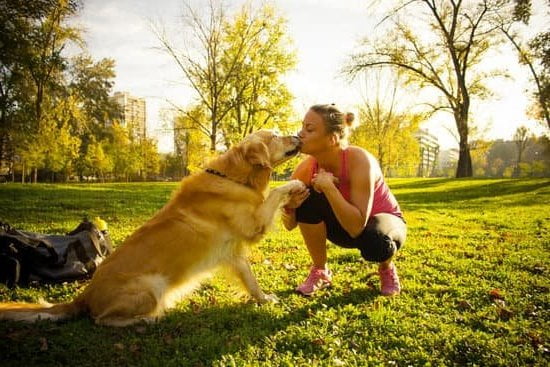Does your dog bark excessively, causing disturbances and frustration? In this article, we will explore how to train your dog to stop barking on command. From understanding the reasons behind excessive barking to choosing the right training methods for your furry friend, we’ll cover everything you need to know to have a well-behaved, quiet companion.
Excessive barking can be a result of various factors such as boredom, anxiety, territorial behavior, or simply needing attention. Training your dog to stop barking on command is essential not only for your sanity but also for your dog’s well-being. By understanding the root cause of their barking and addressing it through effective training, you can create a peaceful living environment for both you and your pet.
When it comes to training methods, it’s crucial to consider your dog’s temperament and breed. What works for one dog may not work for another. We will discuss the importance of choosing the right approach tailored to your dog’s specific needs in order to achieve long-term success in curbing their excessive barking. Stay tuned as we provide a step-by-step guide and tips for reinforcing the training through positive reinforcement and consistency.
The Importance of Training Your Dog to Stop Barking on Command
Excessive barking can be a nuisance for both dog owners and their neighbors. It can also signal an underlying issue, such as anxiety, boredom, or the need for attention. While some amount of barking is natural for dogs, training them to stop on command is crucial for creating a harmonious living environment and preventing potential conflicts with others.
Creating a Peaceful Environment
Training your dog to stop barking on command helps create a peaceful and enjoyable environment for both you and your pet. Excessive barking can lead to tension with neighbors and may even result in complaints or legal issues. By teaching your dog to respond to the quiet command, you can avoid these potential problems and maintain positive relationships with those around you.
Ensuring Safety and Comfort
In addition to preventing disturbances, training your dog to stop barking on command also ensures their safety and comfort. Continual barking can indicate distress or discomfort in dogs, so being able to control their vocalization through the quiet command allows you to address any underlying issues promptly. Moreover, it helps keep your dog calm in various situations, such as when visitors arrive or during walks in busy areas.
Building Trust and Communication
Training your dog reinforces trust and improves communication between you and your pet. It allows your dog to understand boundaries and expectations while strengthening the bond between you. By teaching them the quiet command through positive reinforcement, you establish clear communication that will benefit your broader training efforts and overall relationship with your furry companion.
Choosing the Right Training Methods for Your Dog’s Temperament and Breed
When it comes to training your dog to stop barking on command, it’s essential to consider your dog’s temperament and breed. Different dogs have different learning styles, and what works for one may not work for another. Understanding your dog’s breed characteristics can also play a significant role in choosing the right training methods.
For example, some breeds are known for being more vocal than others, such as hounds and terriers. These breeds may require a different approach to training compared to more quiet and reserved breeds. Additionally, considering your dog’s temperament is crucial. Some dogs may respond well to positive reinforcement techniques, while others may require a firmer hand.
When choosing the right training methods for your dog’s temperament and breed, it’s important to do your research and consult with a professional if needed. Positive reinforcement training is often effective for most dogs, but some may benefit from clicker training or other specific methods. By understanding your dog’s individual needs, you can tailor your training approach to best suit them.
In summary, the key to successfully training your dog to stop barking on command lies in choosing the right methods that align with their temperament and breed characteristics. Taking the time to understand your dog’s individual needs will ultimately lead to more effective and successful training outcomes.
Step-by-Step Guide to Teaching the Quiet or Stop Command
Training your dog to stop barking on command is an essential skill for both you and your pet. Not only does it help maintain a peaceful environment, but it also strengthens the bond between you and your furry friend. When teaching the quiet or stop command, it’s crucial to be patient and consistent, as with any training process.
The first step in teaching the quiet or stop command is to choose a specific word or gesture that will serve as the cue for your dog to stop barking. It can be “quiet,” “enough,” a hand signal, or any other prompt that you feel comfortable using consistently. Once you’ve decided on the cue, make sure to always use the same word or gesture during training sessions.
Next, create a controlled environment where your dog is likely to bark, such as when someone rings the doorbell. As soon as your dog starts barking, firmly but calmly say the chosen cue while making direct eye contact with them. Simultaneously, hold a small treat close to their nose to get their attention and then move it upwards towards their forehead. This action usually causes dogs to naturally stop barking and focus on the treat.
Once your dog stops barking upon hearing the cue and seeing the treat, immediately praise them and give them the treat. Consistently repeating these steps during training sessions will help associate the cue with stopping barking in your dog’s mind. Remember that every dog learns at its own pace, so be patient and persistent throughout this process.
| Training Step | Description |
|---|---|
| Choose a Cue | Select a specific word or gesture to use as the command for stopping barking. |
| Controlled Environment | Create a situation where your dog is likely to bark (e.g. doorbell ringing) and use the cue when they start barking. |
| Treat Reward | Use a treat to redirect your dog’s attention when they stop barking after hearing the cue. |
Reinforcing the Training Through Positive Reinforcement and Consistency
Reinforcement is a crucial aspect of training your dog to stop barking on command. Positive reinforcement involves rewarding your dog for displaying the desired behavior, in this case, being quiet when commanded. Consistency is also key, as your dog needs to understand that the command applies in all situations.
One effective method of reinforcing training is using treats as rewards. When your dog responds to the quiet or stop command, offer a small treat as a form of positive reinforcement. Over time, your dog will associate obeying the command with receiving a reward, making them more likely to comply.
In addition to treats, verbal praise and affection are also important forms of positive reinforcement. When your dog stops barking on command, use a happy tone of voice and pet them to show approval. This will strengthen the association between the command and positive outcomes.
| Positive Reinforcement | Consistency |
|---|---|
| Treats as rewards | Applying the command in all situations |
| Verbal praise and affection | Using the same command consistently |
Dealing With Specific Barking Triggers and How to Address Them
When it comes to training your dog to stop barking on command, it’s important to understand the specific triggers that cause excessive barking. By identifying these triggers, you can effectively address them through proper training and behavior modification. Here are some common barking triggers and how to address them:
1. Doorbell or knocking: Many dogs bark excessively when they hear the doorbell or someone knocking at the door. To address this trigger, you can desensitize your dog to these sounds by using recordings of doorbells or knocking at a low volume. Gradually increase the volume over time while providing positive reinforcement for quiet behavior.
2. Loneliness or boredom: Dogs who are left alone for long periods may bark out of loneliness or boredom. To address this trigger, consider providing interactive toys, puzzle feeders, or even a dog walker during the day to keep your dog entertained and mentally stimulated.
3. Territorial behavior: Some dogs bark excessively in response to perceived intruders or threats to their territory. To address this trigger, work on socializing your dog with different people and animals in a positive and controlled manner. Additionally, teaching your dog the “quiet” command can help redirect their attention away from perceived threats.
By understanding and addressing specific barking triggers, you can effectively train your dog to stop barking on command in various situations. It’s important to be patient and consistent in your training efforts while also seeking professional guidance if needed for more challenging cases of excessive barking.
Troubleshooting Common Challenges in Training
Identifying the Root Cause of Barking
One common challenge when training a dog to stop barking on command is identifying the root cause of their excessive barking. Dogs may bark due to fear, boredom, territorial behavior, or simply as a way of seeking attention. In order to effectively address the issue, it’s important to understand what triggers your dog’s barking and then tailor your training approach accordingly.
Consistency in Training
Another challenge that many dog owners face is maintaining consistency in their training efforts. It’s essential to be patient and persistent when teaching your dog to stop barking on command. Ensure that all family members are on the same page when it comes to implementing the training methods and using the quiet or stop command. Inconsistency can confuse your pet and hinder their progress in learning when it’s appropriate to be quiet.
Managing Frustration
Training a dog to be quiet can be frustrating at times, especially if they have been exhibiting excessive barking for an extended period. It’s important for dog owners to manage their own frustration and remain calm throughout the training process.
Losing patience with your pet can have a negative impact on their willingness to learn. Remember that positive reinforcement is key, and celebrating even small victories can make a big difference in your dog’s ability to pick up on the desired behavior.
By addressing these common challenges in training, you will be better equipped to successfully teach your dog to stop barking on command and enjoy a more peaceful living environment with your furry companion.
The Benefits of Having a Well-Behaved, Quiet Dog in Your Home
Having a well-behaved, quiet dog in your home can bring numerous benefits to both you and your furry companion. When your dog is trained to stop barking on command, it creates a harmonious and peaceful environment for everyone in the household. Here are some of the benefits of having a well-behaved, quiet dog in your home:
- Reduced Stress: Excessive barking can be stressful for both the dog and the owner. By training your dog to stop barking on command, you can reduce stress levels for everyone in the household.
- Improved Relationships: A well-behaved, quiet dog can enhance the relationship between you and your pet. It creates a sense of trust and understanding, leading to a stronger bond.
- Pleasant Environment: A quiet home is more enjoyable for both the residents and visitors. Your trained dog will not disturb or intimidate guests with incessant barking.
In addition to these benefits, having a well-behaved, quiet dog demonstrates responsible pet ownership. It shows that you are committed to training and caring for your canine companion, which reflects positively on both you and your pet.
Ultimately, the joy and freedom that come with having a well-trained, quiet companion make the effort put into training worthwhile. When your dog understands how to control their barking behavior, it leads to a happier coexistence between human and animal within the home.
Conclusion
In conclusion, training your dog to stop barking on command is not only beneficial for you as the owner, but it also greatly benefits the happiness and well-being of your furry companion. By understanding the reasons behind excessive barking and choosing the right training methods for your dog’s temperament and breed, you can successfully teach them to be quiet on command.
This not only creates a peaceful environment in your home, but it also strengthens the bond between you and your pet.
Through positive reinforcement and consistency, you can reinforce the training and help your dog understand what is expected of them. Addressing specific barking triggers and troubleshooting common challenges in training will further contribute to the success of teaching your dog to be quiet on command. The result is a well-behaved, quiet companion that brings joy and freedom to your life.
Ultimately, having a well-trained, quiet dog in your home brings numerous benefits. It allows you to enjoy a peaceful living space, improves the relationship with your pet, and enhances their overall well-being. The effort put into training your dog will be rewarded with a loyal companion who brings joy and freedom to your life every day.
Frequently Asked Questions
What Is the Command to a Dog to Stop Barking?
The command to a dog to stop barking is typically “quiet” or “enough”. These commands should be given in a firm but calm tone, and it’s important to use positive reinforcement when the dog follows the command by giving them a treat or praise.
How Do You Discipline a Dog to Stop Barking?
Disciplining a dog to stop barking involves using positive reinforcement techniques such as teaching the “quiet” command, ignoring the barking, and then rewarding the dog when they stop barking. It’s important not to yell at or physically punish the dog for barking, as this can cause fear and anxiety.
What Is the Fastest Way to Stop a Dog Barking?
The fastest way to stop a dog from barking usually involves identifying the trigger for their barking and addressing it directly. This may involve removing the trigger, providing distractions or mental stimulation for the dog, or seeking professional training assistance if the problem persists.
Identifying and addressing the underlying cause of the barking is key to stopping it quickly and effectively.

Welcome to the blog! I am a professional dog trainer and have been working with dogs for many years. In this blog, I will be discussing various topics related to dog training, including tips, tricks, and advice. I hope you find this information helpful and informative. Thanks for reading!





